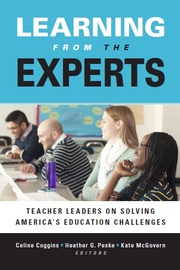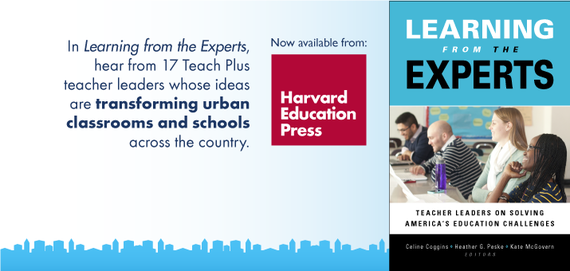Published by Harvard Education Press, Learning from the Experts: Teacher Leaders on Solving America's Education Challenges is a celebration of teachers as change makers. In it, readers will hear from 17 teacher leaders whose ideas and tenacity are transforming urban classrooms and schools nationwide.
This week, read an excerpt from Chapter Five: Engaging Early Career Teachers in the Union by Karen McCarthy and these responses by NEA/Teach Plus Future of the Profession Fellows Jane Rezos and Stephanie Molloy.
Jane Rezos:
I have taught in Memphis, TN for ten years and have to come clean about something. I am a member of my local union, but really know very little about it and what it does for teachers. I thought I was the exception, but I have come to learn that I am really more of the norm. How can I change this? More importantly, how can unions change this and get more teachers active and involved early in their career?
Prior to the first Teach Plus/NEA Future of the Profession Fellowship meeting, I reflected on why I had not become more involved with my local union when I first started teaching. As a new teacher, I would have welcomed any opportunity to network with other new teachers or be mentored by a seasoned teacher. But I really didn't even know that the union existed. If local unions want to engage new teachers, they have to reach out early and often with opportunities for teachers to get involved.
I'd like my union to be the first organization I turn to for professional growth opportunities. For example, the union could offer a mentoring program for new teachers, leadership opportunities for all experience levels, and high-quality professional development workshops. To make sure teachers take advantage of these opportunities, especially in the early years of their careers, communication is the key. Unions need to look beyond the annual or quarterly newsletter. Teachers should be able to check what is happening in the local union when they log in to Facebook or check Twitter. I want the union to tell me what they are working on right now and how I can contribute: Is there a committee or focus group I could join? Do you need me to respond to a survey or send my feedback?
When unions reach out to teachers via numerous platforms and on a regular basis, they need to be prepared for more regular feedback. More importantly, they need to be prepared to act upon the feedback in order to invest and engage members.
Stephanie Molloy:
Teachers use differentiated instruction to deliver appropriate content to every student in their classroom. By differentiating instruction based on student needs, high need students can receive one-on-one attention while advanced students pursue more challenging content. Just like our students, every teacher deserves support and opportunities to be successful. The union has a responsibility to identify the individual needs of its members and develop appropriate support for members in all stages of their careers.
Members just beginning their careers should receive career advice, professional development, and constant communication from their union on issues and policies that will impact their classrooms. Collaborating with district leadership on staff training and in-service opportunities is one way the union can assert itself as an organization that supports the growth of its members. This can also be emphasized through career advisory and assistance.
Veteran teachers and teachers nearing retirement should be equally supported. A veteran teacher will need assistance with maintaining licensure, preparing for retirement both personally and professionally, and continuing professional development as educators are never done improving their craft.
Restructuring positions within the local union is one way to allow for greater flexibility and targeted resources for all members. In addition to a President, Vice-President, Secretary, and Treasurer, why not have a Retirement and Benefits Chair, Career Advisory Chair, Professional Development Chair, and Public Relations Chair? A Retirement and Benefits Chair can guide members through life events that may require changes to health insurance, navigation of the sick leave, and 403B annuities. The Career Advisory Chair could assist in the licensure process, lay-off support, and goal setting for educators in all stages of their career. A Professional Development Chair could work directly with district leadership to ensure that all staff receives the appropriate training and support in the wake of changing education policy or reformed district initiatives. Finally, a Public Relations Chair can facilitate constructive outward communication on the teaching profession and mission of the union. Establishing these positions can allow the president to support its members effectively in a variety of ways.
Jane Rezos teaches Algebra I at Central High School, a Shelby County school in Memphis, TN. This is her eleventh year of teaching and she is a member of the Teach Plus Teaching Policy Fellowship (2012-13 cohort). She is a member of the Memphis Education Association, Tennessee Education Association, National Education Association, and the National Council of Teachers of Mathematics.
Stephanie Molloy is a high school Mathematics teacher in Plymouth, Massachusetts. She has served on multiple leadership committees to include a school-wide literacy program, authentic assessment and inquiry-based learning program, and a PAWGS leadership committee that involves out-of-district meetings with Education leaders in the New England area. Molloy is a current NEA/Teach Plus Future of the Profession Fellow.
Want more from Learning from the Experts? Read an excerpt from the introduction by Teach Plus CEO Celine Coggins, or this essay by NEA/Teach Plus Future of the Profession Fellow Rob Powers.

